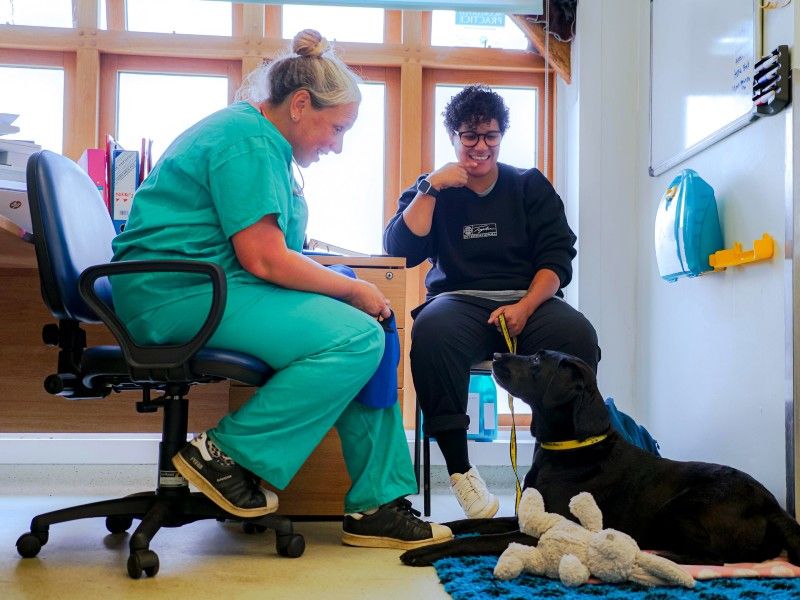How to have a happy vet visit
Help your pooch feel better about vet visits, from arriving at the clinic to being checked in the examination room.

Visiting the vet is a fact of life for dogs and their owners. While some of our four-legged friends may not enjoy the experience, it doesn’t have to be traumatic for them. By following our advice, you can help your pooch feel better about vet visits, from arriving at the clinic to being checked in the examination room.
Get your dog used to being touched at home
Make visiting the vet a more positive experience for your dog by taking the time to drop in even when you don’t need to go – perhaps once a week during a walk. You could ask the practice staff to give your dog some tasty treats and a nice fuss each time, but only if you know your dog enjoys this. That way, your dog will build up warm, positive feelings about the vet. When your dog next needs to see them, the visit should be less stressful. One of the things many dogs dislike about visiting the vet is being handled, especially in places they are not used to being touched. You can help your dog by getting them used to being touched long before you go to the vet by following our step-by-step guide. Remember, as with so many aspects of dog training, the ‘little and often’ approach tends to work best, so set aside some time each week and make this part of your playtime.
Start with somewhere they're comfortable with
Start at home by touching them on a part of their body you know they're comfortable with. This is often the chest or behind the ears. Leave your hand there for no more than three seconds, then give them a treat, and let them relax.
Then try touching a new area
Gradually move your hand to a new area, perhaps the front leg, for a maximum of three seconds, and give a treat each time. If your dog looks uncomfortable at any point, stop what you are doing.
Take it slowly
Remember to take this ‘touch and treat’ approach slowly. You’re aiming to be able to eventually touch your dog on their paws, lift up their tail, look in their mouth – all of the things a vet may need to do during an examination.
Increase the time
Very slowly, you can lengthen the time you leave your hand on them, building up from three to 10 seconds.
Tips when booking a consultation
Due to a rise in people getting dogs during the pandemic, vets across the country are stretched thin. This has resulted in many owners finding it more difficult to get a consultation for vet care, vaccinations and procedures.
We recommend that if you have concerns about your dog, you should ring your vet practice directly for advice. While waiting to be connected, you can also use your vet’s online symptom check (if available), and our list of signs that your dog should see a vet, to assess how urgently your dog needs to be seen.
Booking in a double appointment can give you extra time to ask the vet a few more questions. This will likely cost more but ask before booking.
Tips for the waiting room
- When you visit the vet with your dog, try bringing their favourite toy, blanket, or both. This should help them feel more relaxed and secure.
- If you can, sit well away from the door. Dogs can find it difficult to relax near this busy area, so the further away you can be, the better.
- It can also be helpful to make sure your dog is facing away, and spaced out from, other dogs. That’ll be easier if you make an appointment for a quieter time at the vet practice.
- Gently encourage your pooch to focus on you. This will help them avoid eye contact with other dogs, which is often a cause of tension or frustration within the confined space of a waiting room.
In the examination room
At the vet, you are your dog’s best friend, and they are relying on you to speak up for them. If they get stressed or begin to growl in the examination room, you could politely but firmly ask your vet to stop what they are doing.
Both your dog and your vet will thank you for speaking up. Ignoring your dog or telling them off could make the situation worse.
Growling, or tensing up, are your dog’s way of saying ‘I am really uncomfortable!’ but your vet might be so absorbed with examining your dog that they don’t notice. It’s important to tell your vet what’s happening – after all, you’re the owner, and know your pet best.
A dog may bite during a vet examination because the owner and the vet ignored the dog’s growling, and the dog felt they had no other way to show how unhappy they felt in that situation.
Being aware of the different ways your dog is communicating with you will help to make sure every visit to the vet is a happy one.



